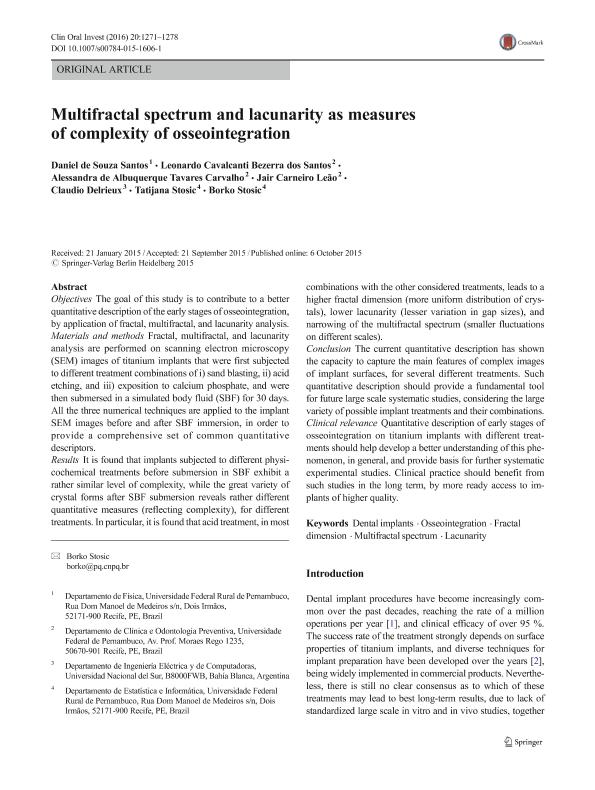Mostrar el registro sencillo del ítem
dc.contributor.author
de Souza Santos, Daniel
dc.contributor.author
Cavalcanti Bezerra dos Santos, Leonardo
dc.contributor.author
de Albuquerque Tavares Carvalho, Alessandra
dc.contributor.author
Carneiro Leão, Jair
dc.contributor.author
Delrieux, Claudio Augusto

dc.contributor.author
Stosic, Tatijana
dc.contributor.author
Stosic, Borko
dc.date.available
2018-06-12T18:36:37Z
dc.date.issued
2016-07
dc.identifier.citation
de Souza Santos, Daniel; Cavalcanti Bezerra dos Santos, Leonardo; de Albuquerque Tavares Carvalho, Alessandra; Carneiro Leão, Jair; Delrieux, Claudio Augusto; et al.; Multifractal spectrum and lacunarity as measures of complexity of osseointegration; Springer Heidelberg; Clinical Oral Investigations.; 20; 6; 7-2016; 1271-1278
dc.identifier.issn
1432-6981
dc.identifier.uri
http://hdl.handle.net/11336/48391
dc.description.abstract
Objectives: The goal of this study is to contribute to a better quantitative description of the early stages of osseointegration, by application of fractal, multifractal, and lacunarity analysis. Materials and methods: Fractal, multifractal, and lacunarity analysis are performed on scanning electron microscopy (SEM) images of titanium implants that were first subjected to different treatment combinations of i) sand blasting, ii) acid etching, and iii) exposition to calcium phosphate, and were then submersed in a simulated body fluid (SBF) for 30 days. All the three numerical techniques are applied to the implant SEM images before and after SBF immersion, in order to provide a comprehensive set of common quantitative descriptors. Results: It is found that implants subjected to different physicochemical treatments before submersion in SBF exhibit a rather similar level of complexity, while the great variety of crystal forms after SBF submersion reveals rather different quantitative measures (reflecting complexity), for different treatments. In particular, it is found that acid treatment, in most combinations with the other considered treatments, leads to a higher fractal dimension (more uniform distribution of crystals), lower lacunarity (lesser variation in gap sizes), and narrowing of the multifractal spectrum (smaller fluctuations on different scales). Conclusion: The current quantitative description has shown the capacity to capture the main features of complex images of implant surfaces, for several different treatments. Such quantitative description should provide a fundamental tool for future large scale systematic studies, considering the large variety of possible implant treatments and their combinations. Clinical relevance: Quantitative description of early stages of osseointegration on titanium implants with different treatments should help develop a better understanding of this phenomenon, in general, and provide basis for further systematic experimental studies. Clinical practice should benefit from such studies in the long term, by more ready access to implants of higher quality.
dc.format
application/pdf
dc.language.iso
eng
dc.publisher
Springer Heidelberg

dc.rights
info:eu-repo/semantics/openAccess
dc.rights.uri
https://creativecommons.org/licenses/by-nc-sa/2.5/ar/
dc.subject
Dental Implants
dc.subject
Osseointegration
dc.subject
Fractal Dimension
dc.subject
Multifractal Spectrum
dc.subject
Lacunarity
dc.subject.classification
Ingeniería Médica

dc.subject.classification
Ingeniería Médica

dc.subject.classification
INGENIERÍAS Y TECNOLOGÍAS

dc.title
Multifractal spectrum and lacunarity as measures of complexity of osseointegration
dc.type
info:eu-repo/semantics/article
dc.type
info:ar-repo/semantics/artículo
dc.type
info:eu-repo/semantics/publishedVersion
dc.date.updated
2018-06-07T16:12:01Z
dc.identifier.eissn
1436-3771
dc.journal.volume
20
dc.journal.number
6
dc.journal.pagination
1271-1278
dc.journal.pais
Alemania

dc.journal.ciudad
Heidelberg
dc.description.fil
Fil: de Souza Santos, Daniel. Universidade Federal Rural Pernambuco; Brasil
dc.description.fil
Fil: Cavalcanti Bezerra dos Santos, Leonardo. Universidade Federal de Pernambuco; Brasil
dc.description.fil
Fil: de Albuquerque Tavares Carvalho, Alessandra. Universidade Federal de Pernambuco; Brasil
dc.description.fil
Fil: Carneiro Leão, Jair. Universidade Federal de Pernambuco; Brasil
dc.description.fil
Fil: Delrieux, Claudio Augusto. Consejo Nacional de Investigaciones Científicas y Técnicas. Centro Científico Tecnológico Conicet - Bahía Blanca; Argentina. Universidad Nacional del Sur. Departamento de Ingeniería Eléctrica y de Computadoras; Argentina
dc.description.fil
Fil: Stosic, Tatijana. Universidade Federal Rural Pernambuco; Brasil
dc.description.fil
Fil: Stosic, Borko. Universidade Federal Rural Pernambuco; Brasil
dc.journal.title
Clinical Oral Investigations.

dc.relation.alternativeid
info:eu-repo/semantics/altIdentifier/url/https://link.springer.com/article/10.1007%2Fs00784-015-1606-1
dc.relation.alternativeid
info:eu-repo/semantics/altIdentifier/doi/http://dx.doi.org/10.1007/s00784-015-1606-1
Archivos asociados
